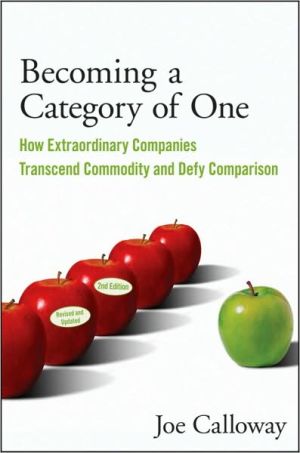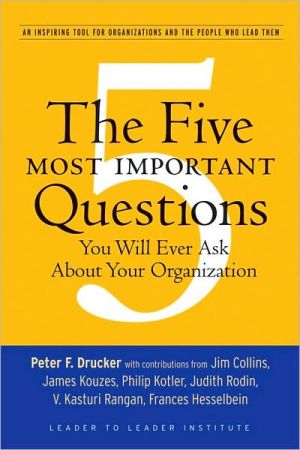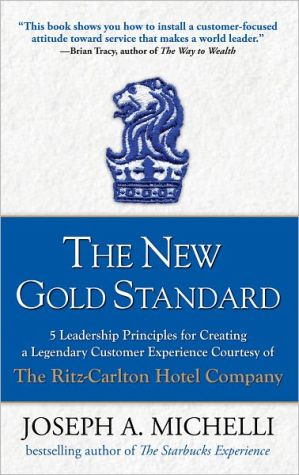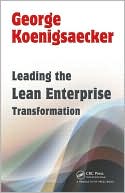Becoming a Category of One: How Extraordinary Companies Transcend Commodity and Defy Comparison
Renowned consultant Joe Calloway has made a career out of helping businesses create competitive advantage through unsurpassed customer service. He knows from experience what separates ordinary companies from companies that dominate the competition. In Becoming a Category of One, he shares the proven business lessons he learned by watching great companies get ahead of the pack and stay there. Ordinary companies compete in their categories, or even lead them. Extraordinary companies create...
Search in google:
Becoming a Category of One, Second EditionJoe Calloway's Becoming a Category of One redefined competition with its lessons on how to truly differentiate yourself in a marketplace of sameness. In this revised and updated Second Edition, Calloway rethinks, repositions, and reenergizes that message. A new chapter on "tiebreakers" provides lessons on differentiation from companies like Zappos, Apple Computer, Netflix, Café du Monde, Hyundai, and In-N-Out Burger.Calloway also includes cutting-edge ideas on the Category of One company of the future from an extraordinary list of guest contributors, including bestselling authors Larry Winget (It's Called Work for a Reason!) and Mark Sanborn (The Fred Factor), Gen-Y expert Jake Greene, Pinnacle Financial Partners CEO Terry Turner, business strategists Randy Pennington and John Spence, branding expert Jack Sims, corporate consultant Chuck Feltz, customer service gurus Scott McKain and John DiJulius, sales and marketing expert Sue Remes, and motivational legend Jim Cathcart.Praise for Becoming a Category of One"Shows what it takes to build a brand on something more than just product. This book inspires us to go for greatness and to win by using our hearts as well as our minds."—Ken Blanchard, coauthor, The One Minute Manager"Becoming a Category of One will delineate how you can differentiate yourself from others who do what you do, how to become positioned in your marketplace, and how to make your customers love you and need you."—Jeffrey Gitomer, author, The Little Red Book of Selling Vanderbilt University, Owen Graduate School of Management, author Respect: Women and Popular Music and Managing with the Wisdom of Love: Uncovering Virtue in People and Organizations - Dr. Dorothy Marcic "If you want to be successful and you want a successful company, read Joe Calloway’s book. It’s as simple as that. It’s the how-to manual that every manager and every employee should be required to read."
Preface1We Just Decided to Go12Know Who You Are243Success Means You Know What Used to Work514The Commodity Trap745Your Brand Is Everything976The Three Rules1227The New Customer Reality1458Case Study - Tractor Supply Company1689The Heart of a Category of One Performer195Index217About the Author223
\ Ken Blanchard"Becoming a Category of One shows what it takes to build a brand on something more than just product. This book inspires us to go for greatness, and to win by using our hearts as well as our minds."\ —author, The One Minute Manager\ \ \ \ \ \ Dr. Dorothy Marcic"If you want to be successful and you want a successful company, read Joe Calloway's book. It's as simple as that. It's the how-to manual that every manager and every employee should be required to read."\ —Vanderbilt University, Owen Graduate School of Management, author Respect: Women and Popular Music and Managing with the Wisdom of Love: Uncovering Virtue in People and Organizations\ \ \ \ Daniel Burrus"If you could have everyone in your company read just one business book, this should be it. Becoming a Category of One is very straight talk about how it's everyone's responsibility to help build the brand."\ —author, Technotrends\ \ \ \ \ \ Publishers WeeklyIn this no-nonsense guide to beating the competition, Calloway, a branding and competitive positioning consultant with clients like BMW and IBM, offers hope to companies confronting a constantly changing and increasingly competitive marketplace. Success, he says, lies in distinguishing yourself from others and forging emotional connections with customers. Before you do anything else, Calloway says, you must answer the question, "Who are you?" unambiguously and with fervor. If your response is vague and uninspiring, Calloway predicts failure, since a lame answer signals lack of vision, focus and commitment, elements he considers essential just to be in the running. An advocate of corporate language that reinforces company identity and motivates employees, Calloway shuns empty slogans and fashionable buzzwords. He snappily makes his point by asking what would have happened if Martin Luther King Jr. had proclaimed, "I Have a Strategic Plan" instead of "I Have a Dream." In no uncertain terms, he asserts companies must pay close attention to each customer and focus marketing on individuals, not abstract demographics. Anyone spacing out while Calloway exhorts innovation and hard work to connect with the customer base in ways that Starbucks, Southwest Airlines and others have will hop to when he has a hypothetical customer ask, "Why should I do business with you?" A company without a compelling answer, Calloway believes, will see the customer go elsewhere. But Calloway emphasizes triumph is possible with disciplined application and provides case studies, interviews and anecdotes illustrating successful approaches for earning customer loyalty and for setting businesses apart in their fields. (Aug.) Copyright 2003 Reed Business Information.\ \ \ \ \ Library JournalPrice, product, and even quality don't cut it anymore when it comes to rising above the competition. So says brand consultant Calloway, who offers an energetic piece on branding, company culture, and customers. He looks at the likes of Harley-Davidson, Starbucks, and lesser knowns such as the Nashville-based Tractor Supply Company to show how they have differentiated themselves by creating their own categories. Calloway advises companies to begin by figuring out who they are and what their corporate culture is like. He continues with a discussion of branding, explaining how customer perception of the company actually creates the brand. He then urges companies to break away from the pack by connecting with customers better than the competition does. Calloway includes ample real-world examples from his clients, and the customer-service experiences he cites from his personal and professional lives ring especially true. With companies scrambling to survive in this dicey economy, the book is apropos for all business collections.-Carol J. Elsen, Univ. of Wisconsin Lib., Whitewater Copyright 2003 Reed Business Information.\ \ \ \ \ Soundview Executive Book SummariesWhat if you could completely eliminate your competition from your customers' consideration - would you do it? Of course, you would. These days, so many companies strive to fit into a niche that they must elbow their way past a mass of competitors to do so. Why strive to be a leader in your category when you can create a different category and be the only one in it?\ Such are the lessons to be learned in Becoming a Category of One. By using consultant Joe Calloway's tips and advice, you can avoid being "commoditized" and differentiate yourself and your business from your competitors simply by shifting focus to your customers. Calloway describes real-life examples of companies that have gotten to know their customers very well, and have reaped the benefits of that knowledge in long-term relationships and continuous sales. Armed with proof that true success comes to organizations that can stand alone in their fields, he points out how a little self-discovery can take your business far, and how knowledge of self is critical to creating a successful branding strategy.\ Deciding to Go\ In the film Apollo 13, Tom Hanks' character, astronaut Jim Lovell, reacts to the U.S. landing on the moon by telling his wife, "From now on, we live in a world where man has walked on the moon. It's not a miracle. We just decided to go."\ "Deciding to go" is the first step toward becoming a "Category of One" - making the commitment that creates a new level of success. Unfortunately, it's also the step usually not taken. Most companies never decide to go. They talk a lot about it; they write mission statements and hold meetings, but when it comes down to making that commitment, they back away. Extraordinary companies make very deliberate decisions to go in terms of pursuing greatness; of seeing how far they can go and how successful they can become. Then, in order to sustain that success, they recommit to that decision again and again.\ Go Big or Go Home\ Most companies never get beyond the talking stages of the decision to go. Even though they think they've committed to doing something different and significant, what they've really done is commit to the discussion of doing something different and significant - they talk a good game, but never make a single play. The decision to go must be followed by immediate and significant action - a clear sign throughout the company that signals there's something big going on, made real by action.\ Many companies encounter their first real obstacle at this juncture - informing employees of impending change. They assume - mistakenly - that all employees not only want to be the best, but are also willing to do what it takes in terms of commitment, change and hard work in order to make it happen. This is often a false and, occasionally, dangerous assumption. If the company's leadership is unable to rectify the situation, greatness on any level is virtually impossible - nothing of any substance will take place without the commitment of the employees.\ Straight Answers to Tough Questions\ Companies must confront themselves with these simple yet very tough questions about their stated goals:\ \ Do we really mean this?\ How far are we willing to go to achieve our goals?\ What is our organization's tolerance for chaos?\ Are we willing to let go of everything that works in order to reach our destination?\ Who are we?\ What do we stand for?\ Are we serious about this effort?\ \ \ \ \ There are very serious ramifications involved if your organization is serious about achieving its goals. By answering "Yes," you make the commitment to seeing the effort through. Making the decision to go means you start with an idea and do what must be done to make that vision a reality. Copyright © 2005 Soundview Executive Book Summaries\ \ \








